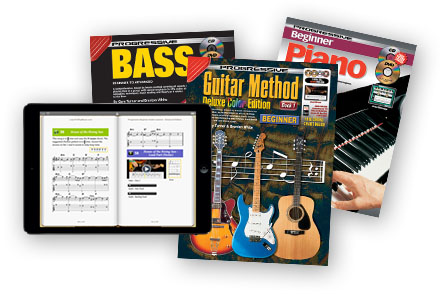<< First < Previous | Intro 1 2 3 4 5 | Next > Last >>
Back to Table of Contents
Fretboard Diagram
A fretboard diagram is a grid pattern of strings (vertical lines) and frets (horizontal lines) which is used to indicate the position of notes.
The first example opposite uses the open (not fretted) first string. Because the open 1st string is a G note it is called the G string. The note on the second fret of the G string is an A note. It is played with the second finger of the left hand placed just behind the second fret.
The note should sound full and round. If it buzzes or rattles you have not placed your left hand finger close enough to the fret, and you are not pressing the string down hard enough. If the note sounds ‘muffled’ your finger is on the fret instead of just behind it.
In the count written underneath the note, the large number indicates that the note is played. The small numbers indicate that the note is held.
Chord Symbols
The letters above the staff are chord symbols. Chords are groups of notes played by the rhythm guitarist or keyboard player. Listen to the recording and you will be able to play along with the chords.
There are three types of chords used in this book. They are the most common chord types, i.e.: major, minor (m) and seventh (7) chords.
Major |
Minor |
Seventh |
|
| e.g.: | A (A major) | Am (A minor) | A7 (A seventh) |
In the following example there are four quarter notes in each bar and one whole note in the last bar. The metronome symbol  indicates the count.
indicates the count.
| 1 | (Fingers) |
Video
Audio – Solo Track
Audio – Backing Track
| 1 | (Pick) |
Video
Audio – Solo Track
Audio – Backing Track
- Playing with the pick – when using a pick, play quarter notes with a downward pick motion as indicated by the symbol
 .
. - Playing with the fingers – when playing the strings with your right hand fingers, anchor your thumb on the pickup and strike the A note with your index finger (i). As soon as it comes to rest on the 2nd string, pick the A note again, this time using your middle finger (m). Maintain this alternating movement between i and m. Make sure one of the two fingers is always resting on the 2nd string while the other is picking the 1st string and vice versa. Always use this alternating finger style as it will give you more possibilities when changing between notes and strings. It is important to be equally comfortable starting with either the i finger or m finger. Practice each example starting with i and alternating, and then with m and alternating.
| 2 | (Fingers) |
Video
Audio – Solo Track
Audio – Backing Track
| 3 | (Fingers) |
Video
Audio – Solo Track
Audio – Backing Track
| 3 | (Pick) |
Video
Audio – Solo Track
Audio – Backing Track
<< First < Previous | Intro 1 2 3 4 5 | Next > Last >>
Back to Table of Contents











































